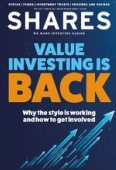Archived article
Please note that tax, investment, pension and ISA rules can change and the information and any views contained in this article may now be inaccurate.
The risks of investing in bonds: everything you need to know

For over a decade following the global financial crisis, bonds offered little in the way of return and carried significant price risk. But the return of inflation and higher interest rates have changed all that.
You can now get a 4.5% annual yield on a UK government bond maturing in 10 years’ time. That compares to under 0.2% in the depths of the pandemic in 2020.
To spell out the gargantuan difference between these two yields, if you invested £10,000 in a bond yielding 0.2% and held it to maturity, you would get back £10,202 after 10 years. If instead the bond was yielding 4.5%, you would get back £15,530.
THE OPPORTUNITIES FOR INVESTORS
The yields currently available on bonds are definitely tempting, more so because we have come through such a long period of yield deprivation.
Bonds, especially government bonds, are also traditionally seen as less risky than equities, because they tend to be less volatile.
They often move in the opposite direction to shares too, making them a good diversifier for an equity portfolio. That may be so, but there are still risks to investing in bonds, which investors need to consider.
THE RISK OF DEFAULT
When you buy a bond, you are effectively lending money to a government or company. They may fail to pay back all, or just some, of the capital and interest they have promised.
The risk of default depends on the financial strength of the government or company to whom you are lending money.
Generally speaking, lending to well-financed governments in the developed world, like the US, UK and Germany, is very safe, because these countries are unlikely to default on their debt.
If they did default, it would mean these countries would have to pay more on international debt markets to borrow again.
Emerging market governments are more prone to default. For instance, Argentina has defaulted on its debt nine times. Consequently its bond yields are eye-wateringly high, but attract only the most risk-hungry investors.
In developed markets it’s riskier to lend to companies than it is to governments. The latter can raise money through taxation to service debts, but Unilever (ULVR), for example, can’t make us buy more of its Ben & Jerry’s ice cream.
DIFFERENT GRADES OF BONDS
Corporate bonds are normally divided into investment grade and high yield or ‘junk’ bonds.
Investment-grade bonds get a strong score from the credit rating agencies because their finances are relatively robust, so they are judged to be able to handle their debts.
An S&P rating of BBB and above is deemed to be ‘investment grade’ (the ratings run from AAA through to D).
Companies with a credit rating below this level fall into the ‘high yield’ bucket, and as the name suggests, they have to offer more interest to lenders to make up for their shakier balance sheets.
This is common throughout the bond universe; the more risk you take, the higher the yield becomes.
It’s possible to mitigate the risk of default by investing in bonds via funds, which hold a diversified portfolio of loans to many different companies. However, in tough economic times, or times of rising interest rates, the number of defaults in any portfolio can be expected to grow.
INTEREST RATE RISK
The other big risk to consider is interest rate risk. When you lend money via a bond, you lock into a certain interest rate.
If market rates rise after you’ve bought in, you’re stuck in something that might offer a relatively paltry rate of return.
Anyone who locked into a 0.2% annual yield from UK gilts in 2020 is probably kicking themselves because they could now have picked up an interest rate of 4.5%.
This dynamic will also hurt the paper value of your bond holdings, because if interest rates rise, this will almost certainly mean your bond falls in value. This effect will be bigger for longer dated bonds.
You will still get your money back if you hold the bond to maturity, assuming there’s no default, but if you want to sell at a market price this may well be lower than what you paid for it.
INFLATION RISK
Bond investors are also typically open to inflation risk. The cash flows from a conventional bond are fixed when you buy it, they don’t go up and down.
If inflation goes up, those cash flows can be left looking less attractive. This will probably reduce the price of the bond but will also mean the income being provided will have less spending power.
Consider again our hypothetical investor who bought a UK gilt yielding 0.2% in 2020, only to see inflation hit double digits a couple of years later. Not a happy scenario by any stretch of the imagination.
It’s possible to buy bonds where the interest payments and capital are linked to inflation, such as index-linked gilts. However, you normally have to accept a lower starting yield in exchange for the inflation protection, and as ever, existing market expectations for future inflation will already be baked into prices.
The bond market has woken up and is offering more compelling value than it has for a long time. Investors need to consider a bond allocation in the context of other assets though, chiefly equities and cash.
For those who don’t wish to run a portfolio of different assets, a multi-asset fund might be the ticket. These funds offer a blend of shares, bonds and cash, and sometimes property and alternative assets like gold and commodities too. They come in a variety of risk levels and can be a useful one-stop shop for those who want a more hands-off approach to their investment portfolio.
Important information:
These articles are provided by Shares magazine which is published by AJ Bell Media, a part of AJ Bell. Shares is not written by AJ Bell.
Shares is provided for your general information and use and is not a personal recommendation to invest. It is not intended to be relied upon by you in making or not making any investment decisions. The investments referred to in these articles will not be suitable for all investors. If in doubt please seek appropriate independent financial advice.
Investors acting on the information in these articles do so at their own risk and AJ Bell Media and its staff do not accept liability for losses suffered by investors as a result of their investment decisions.
Issue contents
Exchange-Traded Funds
Feature
Great Ideas
News
- Tesla investors left sweating over scope for margins recovery
- Netflix ‘turnaround complete’ as cash flow soars in the third quarter
- Big medical breakthrough drives huge gains in Oxford Biodynamics shares
- Why global bond yields continue to shoot up and what it means
- Rightmove shares endure a big hit as US real estate giant CoStar agrees OnTheMarket deal
- Margins may hold the key to PayPal recovery
- Grocery chain Sainsbury’s needs to deliver on earnings and guidance
- ‘Writing on the wall’ for open-ended property funds as M&G closes once popular product
 magazine
magazine








